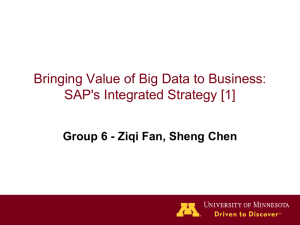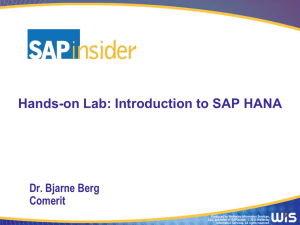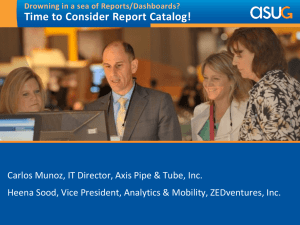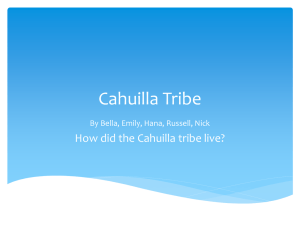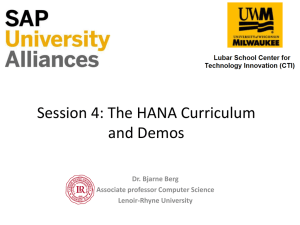SAP_HANA_Dr_Berg_Sapphire_2013
advertisement
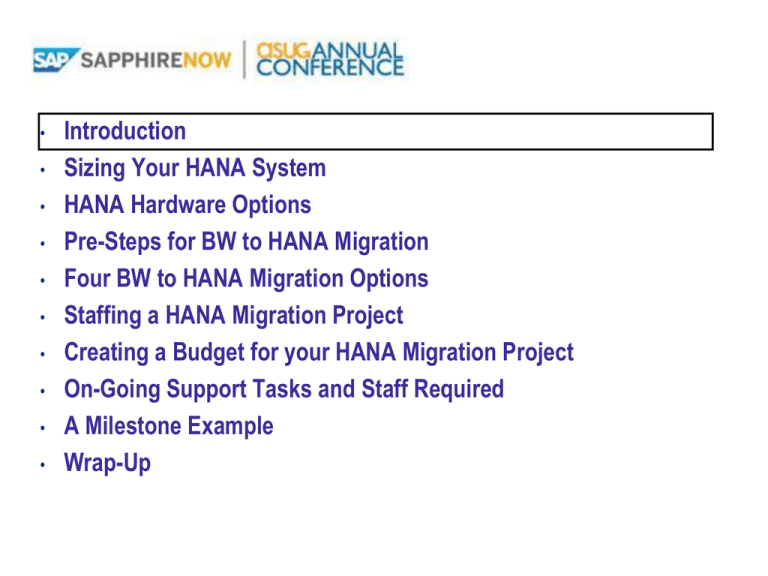
• • • • • • • • • • Introduction Sizing Your HANA System HANA Hardware Options Pre-Steps for BW to HANA Migration Four BW to HANA Migration Options Staffing a HANA Migration Project Creating a Budget for your HANA Migration Project On-Going Support Tasks and Staff Required A Milestone Example Wrap-Up Introduction • HANA is an in memory solution that can take large volumes of data, compress it, and store it for extremely fast access by thousands of users. • It is the ‘engine’ of the next generation of computer systems for analytics and transaction processing SAP HANA, as of 2013, can be used as the in-memory database for BusinessSuite, BW and SAP’s BusinessOne Solution An Alternative SAP BW on HANA Sizing Tool SAP has released a new ABAP based tool that generates a report significantly better sizing fro SAP BW than using just the QuickSizer above. This program takes into consideration existing database compression, different table types and also include the effects of non-active data on the HANA system. The higher precision you run the estimate at the longer the program is going to run. With 14 parallel processors and 8Tb data warehouse, it is not unusual to see 4575 minutes run time. To increase speed, you can also suppress analysis tables with less than 1 MB size. SAP BW on HANA Sizing Tool Since timeouts are common when running the sizing program, you can temporarily change the parameter in rdisp/max_wprun_time to 0 in BW transaction RZ11. Finally, you estimate the growth for the system as a percentage, or as absolute growth. After you have downloaded and installed the program, and-selected the parameters above, you can go to SE38 and run SDF/HANA_BW_SIZING as a background job. The output is stored in the file you specified and the file can now be email emailed to hardware vendors for sizing input and hardware selection. This program is attached to SAP Note: 1736976 on SAP Marketplace A T-Shirt Model for Sizing HANA on BW A T-shirt model is a quick way to get some basic ideas on what a system may look like. While very inaccurate for sizing, it provides basic information for those just staring considering SAP HANA Data Compress ion (from) Working Memory Processors SAS/SSD (for data) Replication Speed (per hour) Extra Large (XXL) 7000–100,000 GB 3072 GB 12+ Intel E7 2.4 Ghz 10+ TB 20+ GB Very Large (XL) 3500–7000GB 2048 GB 8+ Intel E7 2.4 Ghz 5 – 10 TB 20+ GB Large (L) 2000–3500GB 1024GB 4 x Intel E7 2.4 Ghz 4 - 5 TB 5–20GB Medium (M) 1250– 2000GB 512GB 4 x Intel E7 2.0+ Ghz 2048GB 5–20 GB Small (S) 500– 1250GB 256GB 2 x Intel E7 2.0+ Ghz 1024GB 5GB Extra Small (XS) 256– 500GB 128GB 2 x Intel E7 2.0+ Ghz 1024GB 5GB to 20+ TB (multi node) (multi node) The number of processors are largely driven by the number of users and usage patterns. Serious consideration should be made before buying hardware. • • • • • • • • • • Introduction Sizing Your HANA System HANA Hardware Options Pre-Steps for BW to HANA Migration Four BW to HANA Migration Options Staffing a HANA Migration Project Creating a Budget for your HANA Migration Project On-Going Support Tasks and Staff Required A Milestone Example Wrap-Up Hardware Options for HANA There are currently 7 different certified HANA hardware vendors with 13 different products. Memory Hardware 128GB Cisco C260 X Cisco C460 256GB X X X X+ X Dell R910 X X X Hitachi CB 2000 X X X X X X X NEC Express 5800 Fujitsu RX 600 S5 X Fujitsu RX 900 S2 HP DL 580 G7 X X X HP DL 980 G7 X+ X+ X X X X+ HP BL 680 X X X IBM x3690 X5 X X X X X IBM x3950 X5 1024GB X Cisco B440 Some boxes can be used as single nodes with others are intended for scale-out solutions for large multi-node systems 512GB X+ A HANA Hardware Example In this box, we are see the inside of an IBM x3950 HANA system. The system basically consists of memory, disk, processors and network cards The hardware vendor will install, connect and to a health check on your system before handing it over to you. A 3-year service plan is also normally required. • • • • • • • • • • Introduction Sizing Your HANA System HANA Hardware Options Pre-Steps for BW to HANA Migration Four BW to HANA Migration Options Staffing a HANA Migration Project Creating a Budget for your HANA Migration Project On-Going Support Tasks and Staff Required A Milestone Example Wrap-Up Pre-Steps – Analyze BW Readiness SAP has a checklist tool for SAP NetWeaver BW powered by HANA (thanks Marc Bernard). In this tool, SAP provided automatic check programs for both the 3.5 version and the 7.x version of BW. These are found in SAP Note: 1729988. In version 2.x of this tool, hundreds of checks are done automatically in the BW system. This includes platform checks on database and application There are even basis checks for support packs, ABAP/JAVA and system information. stacks, Unicode, BW releases, and add-ons to your system. Pre-Steps – Analyze BW Readiness The idea of the checklist tool from SAP is that you run it several times throughout the project. Once before you start, then periodically as you resolve issues and upgrade requirements, and then finally when the system has been migrated to HANA. The checklist tool also has specific checks for the HANA system that can help you identify any issues before turning over the system to end users.. New ABAP Check Program New ABAP Check Program New ABAP Check Program New ABAP Check Program New ABAP Check Program Pre-Steps – Cleaning up your BW System You can save significant amounts of work by doing a cleanup effort before you start your HANA migration or a BW upgrade project. For example, a international company had a BW system with over 108 TB, with only 36TB in the production box and the remaining data on their Near-Line Storage (NLS) solution. This cleaned BW system saved them potentially millions of dollars in hardware and HANA licensing costs. It is not unusual to reduce a BW system size by 20-30% during a clean up effort. 12 Pre-Steps – Cleaning up your BW System 1. Clean the Persistent Staging Area (PSA) for data already loaded to DSOs 2. Delete the Aggregates (summary tables). They will not be needed again. 3. Compress the E and F tables in all InfoCubes. This will make InfoCubes much smaller. 4. Remove data from the statistical cubes (they starts with the technical name of 0CTC_xxx). These contain performance information for the BW system running on the relational database. You can do this using the transaction RSDDSTAT or the program RSDDSTAT_DATA_DELETE to help you. 5. Look at log files, bookmarks and unused BEx queries and templates (transaction RSZDELETE). 6. Remove as much as possible of the DTP temporary storage, DTP error logs, and temporary database objects. Help and programs to do this is found in SAP Notes 1139396 and 1106393. 12 Pre-Steps – Cleaning up your BW System 7) For write-optimized DSOs that push data to reportable DSOs (LSA approach), remove data in the writeoptimized DSOs. It is already available in higher level objects. 8) Migrate old data to Near-Line Storage (NLS) on a small server. This will still provide access to the data for the few users who infrequently need to see this old data. You will also be able to query it when BW is on HANA, but it does not need to be in-memory. 7) Remove data in unused DSOs, InfoCubes and files used for staging in the BW system. This include possible reorganization of masterdata text and attributes using process type in RSPC 12 Pre-Steps – Cleaning up your BW System 10) You may also want to clean up background information stored in the table RSBATCHDATA. This table can get very big if not managed. You should also consider archiving any IDocs and clean the tRFC queues. All of this will reduce size of the HANA system and help you fit the system tables on the master node. 11) In SAP Note 706478, SAP provides some ideas on how to keep the basis tables from growing too fast too fast in the future, and if you are on Service Pack 23 on BW 7.0, or higher, you can also delete unwanted masterdata directly (see SAP Note: 1370848). 12) Finally, you can use the program RSDDCVER_DIM_UNUSED to delete any unused dimension entries in your InfoCubes to reduce the overall system size. • • • • • • • • • • Introduction Sizing Your HANA System HANA Hardware Options Pre-Steps for BW to HANA Migration Four BW to HANA Migration Options Staffing a HANA Migration Project Creating a Budget for your HANA Migration Project On-Going Support Tasks and Staff Required A Milestone Example Wrap-Up Four Options for Migrating BW to HANA There are basically 4 different approaches to migrating your BW system to SAP HANA. Each are slightly different. They may be summarized as: 1. 2. 3. 4. Standard BW to HANA migration without Optimization BW to HANA migration with Optimization BW to HANA migration as a Re-implementation Migrate a Copy of BW to HANA A major decision before you start is to determine which of these options your want to pursue. We will now take a quick look at each of them 1. Standard BW to HANA migration without Optimization • In this approach you treat your BW move to HANA as a database migration project. • This means that you start with the BW system, complete the cleanup and preparations outlined above and migrate the database over to SAP HANA, but leave the application logic and data models the same. • After the migration you will have your database system as HANA, but there are no model changes to your system and there will be no impact to your queries, link to NLS, interfaces or data loads, except for substantially faster performance and some internal changes how HANA processes at the database level (i.e. data activation and compression). Functionally, you have the same system and this approach is therefore the fastest and most common. 2. BW to HANA migration with Optimization • In this approach the migration also involve the optimization of data structures to take advantage of the new capabilities in HANA. This may include HANA optimized Infocubes and DSOs, and ‘HANA hints’ on data transformations to make lookups go faster. • This migration approach is a technical and functional upgrade at the same time. While the impact is minimal, significant additional performance in data loads, and query performance can be achieved. • For very large BW systems, this approach can be very time consuming and require more testing. To reduce this, you can limit the optimization to slow performing areas that need this extra boost, or do the standard upgrade first and then optimize as part of future development efforts, or when enhancing InfoCubes and DSOs. How much additional optimization effort you are willing to undertake depends on the resources available and how fast you have to complete the migration. 3. BW to HANA migration as a Re-implementation • Some organizations have decided to take the BW to HANA migration as a reimplementation approach to also clean up old designs and retire lo longer used InfoCubes, InfoObjects, DTPs, reports, queries and other elements. • The steps involve setting up a new BW system on HANA parallel to the current BW system running on a relational database. Then, for key areas, the InfoCubes and DSOs are transported to the HANA box and the data loads are switched over to the new system as part of smaller projects. • Meanwhile, other InfoCubes and DSOs are running on the old BW relational database based system. Basically you are running two BW systems at the same time, without duplicating the loads to InfoProviders in both systems. While more costly, this approach allows you to keep the old system around and minimize risks of the HANA migration. The outage required is also minimal and can be done over a weekend functional area by functional area. 4. Migrate a Copy of BW to HANA • This alternative approach can be used by organizations with very low risk tolerance and those who have lots of time to migrate BW to HANA. • It involves copying the production BW system, applying notes or upgrades required. Then reconciling the BW and the new BW on HANA system from a functional standpoint. (interfaces, openhubs, reports, analytics, security, and data) • • When the tests are done, the process chains are run and the data is reconciled again. To do this you need to plan carefully and run duplicated process chains to avoid impacts to the ERP system. It requires load programs to load the data to both the BW and the HANA system without impacting delta loads. But, it can be done. After testing, you can switch the users over to the new BW HANA box and de-commission the old BW. Summary of BW to HANA Migration Options Approach Effort Risk Benefits Most Common Standard BW to HANA migration without Optimization BW to HANA migration with Optimization BW to HANA migration as a Re-implementation Migrate a Copy of BW to HANA (no optimization) For many organization a migration of their BW systems to HANA (technical migration), followed by a later functional optimization is the most common approach (so far). • • • • • • • • • • Introduction Sizing Your HANA System HANA Hardware Options Pre-Steps for BW to HANA Migration Four BW to HANA Migration Options Staffing a HANA Migration Project Creating a Budget for your HANA Migration Project On-Going Support Tasks and Staff Required A Milestone Example Wrap-Up Staffing a HANA Migration Project – Small Team System Profile Raw data size: Complexity: DataStores: InfoCubes: Queries: Area 2.7 TB Medium 87 63 409 Duration: 14 weeks Environments: 4+1 Risk aversion: Medium Other usage: IP Core team Test team Role Staff area Jun Company 50% Company 75% Consultant 100% Consultant 100% Consultant 100% Project manager BW Basis Support HANA Basis Support HANA Optimization developer HANA Test & resolution lead Functional Tester - Finance & COPA Business Functional Tester - Sales and Distribution Business Functional Tester - MFG & Sourcing Business Jul Aug Sep 50% 75% 100% 100% 100% 25% 25% 25% 50% 100% 100% 100% 100% 50% 50% 50% 50% 75% 75% 50% 50% This assumes that the test team is dedicated for 3 weeks during the migration of QA and Prod environments The test team from the business is already experienced users of the BW system and need minimal training HANA Optimization of InfoCubes and DSOs are currently for SD only for this organization. This organization is using BWA and will be retiring it as part of the HANA migration Staffing a HANA Migration Project – Medium Team System Profile Raw data size: 5.6 TB Complexity: Medium DataStores: 439 InfoCubes: 603 Queries: 1,300+ Area Role Project manager Technical project manager Core Project Advisor team BW / HANA Basis Support HANA Basis Support BW Technical test lead Test Team: Finance Functional Tester - Finance HANA Test & resolution lead Test Team: SD & Commissions Functional Tester - Sales & Distribution BW Technical tester Test Team: Other Areas Functional Tester - Other areas Staff area Jan Company 25% Consultant 100% Consultant 20% Company 75% Consultant 100% Company Business Consultant Business Company Business Feb Mar Apr May 25% 25% 25% 25% 100% 100% 100% 100% 20% 20% 20% 20% 100% 100% 100% 75% 100% 100% 100% 75% 100% 100% 50% 50% 75% 100% 100% 50% 50% 75% 100% 100% 50% 50% (incl. BOBJ) Duration: 18 weeks Environments: 4 Risk aversion: HIGH Other usage: None This assumes testing of core queries in BEx and WebIntelligence is done by the business The data reconciliation and process chain testing is done by dedicated resources in each team. This team must be staffed with experienced resources. HANA training for team members and hardware installs must be in place prior to project start. Staffing a HANA Migration Project – Very Large Team System Profile Raw data size: 38TB Complexity: High DataStores: 1,300+ InfoCubes: 1,720+ Queries: 2,200+ Duration: 5 mos Environments: 4 Risk aversion: HIGH Other usage: APO, IP, BPC This assumes minimal additional functional optimization Area Role Project manager Technical project manager BW Basis Support Core HANA Basis Support team Project Advisor HANA Optimization developer Support team Representative BW Technical test lead Test Team: HANA Test & resolution lead Finance and Functional Tester - Finance BPC Functional Tester - BPC BW Technical test lead Test Team: HANA Test & resolution lead Sales and Consultant Test team lead and Sales Distribution Functional Tester - Delivery BW Technical test lead Test Team: HANA Test & resolution lead Manufacturing Consultant Test team lead and Sales Functional Tester - Delivery BW Technical test lead Test Team: HANA Test & resolution lead Global Functional Tester - PO and Spend Sourcing Functional Tester - AP and Performance BW Technical test lead Test Team: HANA Test & resolution lead HR and Functional Tester - HR Planning Functional Tester - IP Staff Mar Apr May June July Aug Company Consultant Company Consultant Consultant Consultant Company Company Consultant Business Business Company Consultant Business Business Company Consultant Business Business Company Consultant Business Business Company Consultant Business Business 100% 100% 75% 100% 20% 100% 50% 50% 100% 100% 100% 75% 100% 20% 100% 50% 50% 100% 100% 100% 50% 100% 20% 100% 50% 50% 100% 25% 25% 50% 100% 25% 25% 50% 100% 25% 25% 50% 100% 25% 25% 50% 100% 25% 25% 50% 50% 100% 100% 50% 50% 100% 100% 50% 50% 100% 100% 50% 50% 100% 100% 100% 100% 50% 100% 20% 100% 50% 100% 100% 25% 25% 100% 100% 25% 25% 100% 100% 25% 25% 100% 100% 25% 25% 100% 100% 25% 25% 100% 75% 100% 75% 100% 75% 100% 75% 20% 20% 100% 50% 100% 100% 100% 50% 50% 100% 100% 50% 50% 100% 100% 50% 50% 100% 100% 50% 50% 100% 100% 50% 50% • • • • • • • • • Introduction Sizing Your HANA System HANA Hardware Options Pre-Steps for BW to HANA Migration Four BW to HANA Migration Options Staffing a HANA Migration Project Creating a Budget for your HANA Migration Project On-Going Support Tasks and Staff Required A Milestone Example Wrap-Up Budgeting a HANA Migration Project - Systems There are a set of items you need to budget for. From a system perspective you will need to consider: • Hardware quotes Give at least two vendors your sizing estimate and ask for quotes. • Vendor Support Make sure your hardware vendor include 3-years support in your purchase • Upgrades Plan and budget for any BW upgrades required before going to HANA (7.3) Do the pre-steps BW cleanup we outlined earlier as soon as possible and then the formal sizing effort, before requesting a hardware quote. Mid-Size Budgeting Example HW Quotes - HP This example quote is for a mid-sized 512 GB memory box with 4 x 10 cores CPUs and 7 TB disks based on Hewlett-Packard's high-end DL-980 Box. Including all services and support agreements, this quote is only $150,000 Certified HANA vendors such as HP, IBM, Dell, Cisco, NEC, Hitachi and Fujitsu has dedicated staff to help you get a detailed quote in matter of days. Small Example HW Quotes - Dell This is example is a quote for a smaller 128 GB Memory Box with 2 x 10 cores is based on Dell’s R910 platform for a HANA sidecar usage for less then $40,000 (including tax!) Most of the smaller HANA systems from the other vendors are similarly prices and depends on the number of boxes you buy, existing discount agreements and the size of the deals you are requesting. Expect competitive bids for larger systems and similar vendor pricing for similar capabilities Budgeting a HANA Migration Project - People Remember to budget for HANA training for your employees before the project starts Class schedules are found at: training.sap.com On average plan for $3,000 to $6,000 to train each team member on average plus travelling costs. Budgeting a HANA Migration Project - People • Experienced HANA consultants are in very high demand, so budget $1,600 to $2,300 per day for these resources (US) • Testers with BW experience and some HANA training can be found for more normal consulting rates. • Solid hands-on migration experience with SP4 and SP5 is key for SAP BW to HANA migrations. Don’t confuse this with HANA ‘sidecar’ experience. It is very different. When staffing your HANA project, don’t schedule the start date before you get your staff. You want the best resources, not whoever is available. • • • • • • • • • • Introduction Sizing Your HANA System HANA Hardware Options Pre-Steps for BW to HANA Migration Four BW to HANA Migration Options Staffing a HANA Migration Project Creating a Budget for your HANA Migration Project On-Going Support Tasks and Staff Required A Milestone Example Wrap-Up On-Going Support Tasks and Staff Required Major on-going support tasks consists of: User and role maintenance Security maintenance Backup and disaster recovery Load balancing, monitoring and hardware maintenance Software patches and notes for HANA, BW and Components Cleanup, NLS, Archiving, log deletions Transports, table copies, system copies and data copies Periodic system upgrades While most tasks are similar to the old relational database systems, the way we do this is quite different. Make sure your HANA support staff is onboarded early and trained before cut-over to production of your migration project. On-Going Support Tasks and Staff Required The staffing roles required is normally: - One basis resource for system admin and monitoring for every 4-5 environments (do you need 24-hours support?) - One resource, part-time, for security, roles and access maintenance (depends on number of users) - One BW resource for monitoring loads, issues and fixes (could be part-time role in small and mid-sized organizations) The support of HANA is actually easier than the traditional basis support. Most functions are done in a single interface and many of the tasks are significantly simplified due to the inherent performance of HANA. • • • • • • • • • • Introduction Sizing Your HANA System HANA Hardware Options Pre-Steps for BW to HANA Migration Four BW to HANA Migration Options Staffing a HANA Migration Project Creating a Budget for your HANA Migration Project On-Going Support Tasks and Staff Required A Milestone Example Wrap-Up A Milestone Example ID First we clean the BW system, size the box and do the health check we covered earlier in this session. Then we order hardware and get the vendor to install the hardware. Be prepared for 4-6 weeks lead time for hardware delivery While waiting for hardware, upgrade BW, apply SPS and execute training 1.0 1.1 1.2 1.3 1.4 1.5 2.0 2.1 2.2 2.3 3.0 3.1 3.2 3.3 4.0 4.1 4.2 4.3 4.4 4.5 4.6 4.7 4.8 4.9 5.0 5.1 5.2 5.3 5.4 5.5 5.6 5.7 6.0 6.1 6.2 Task BW Preparations Clean BW system (12 steps) Execute BW readiness check (note: 1729988) Conduct hardware sizing Obtain 2 quotes and select vendor Complete SP install and Upgrades required HANA Install of Hardware Vendor Install of Hardware Install SAP BW software on HANA box Conduct HANA health check Onboarding Execute training for HANA project team Project charter, standards and procedures Setup roles, security and access HANA Migration Copy BW to sandbox Sandbox migration of database Functional test of queries, security and interfaces Test DTPs and loads Checkpoint and lessons learned BW Development box migration Functional test of queries, security and interfaces Test DTPs and loads Copy Prod to QA box BW QA box migration Functional test of queries, security and interfaces Test DTPs and loads Backup Prod and contingency planning BW Prod box migration Functional validation of queries, security and interfaces Validation of DTPs and loads Contingency time Project close Lesson learned and issues review Project close Weeks 1 2 3 4 5 6 7 8 9 10 11 12 13 14 15 16 17 13 A Milestone Example ID Start with refreshing the sandbox from the development environment. Migrate the Sandbox carefully and spend time on testing. Do not rush this part of the project and document all activities (create a migration script of all activities) Plan ‘contingency’ time for any delays and do a cut-over on the weekend. 1.0 1.1 1.2 1.3 1.4 1.5 2.0 2.1 2.2 2.3 3.0 3.1 3.2 3.3 4.0 4.1 4.2 4.3 4.4 4.5 4.6 4.7 4.8 4.9 5.0 5.1 5.2 5.3 5.4 5.5 5.6 5.7 6.0 6.1 6.2 Task BW Preparations Clean BW system (12 steps) Execute BW readiness check (note: 1729988) Conduct hardware sizing Obtain 2 quotes and select vendor Complete SP install and Upgrades required HANA Install of Hardware Vendor Install of Hardware Install SAP BW software on HANA box Conduct HANA health check Onboarding Execute training for HANA project team Project charter, standards and procedures Setup roles, security and access HANA Migration Copy BW to sandbox Sandbox migration of database Functional test of queries, security and interfaces Test DTPs and loads Checkpoint and lessons learned BW Development box migration Functional test of queries, security and interfaces Test DTPs and loads Copy Prod to QA box BW QA box migration Functional test of queries, security and interfaces Test DTPs and loads Backup Prod and contingency planning BW Prod box migration Functional validation of queries, security and interfaces Validation of DTPs and loads Contingency time Project close Lesson learned and issues review Project close Weeks 1 2 3 4 5 6 7 8 9 10 11 12 13 14 15 16 17 13 Where to Find More Information • www.sap-press.com/products/SAP-HANA%3A-An-Introduction.html • SAP HANA: An introduction. Book by Dr. Berg and Penny Silvia published by SAP Press. 2nd edition • http://www.saphana.com/welcome SAP’s Main page for all SAP HANA related information • • • • • http://www.saphana.com/community/try BW Powered by HANA Demo http://scn.sap.com/community/netweaver-bw-hana SAP NetWeaver BW Powered by SAP HANA Community 7 Key Points to Take Home • • • • • • • Cleaning your BW system (12 steps) will make your HANA system smaller and less costly There are programs to do readiness checks for a BW system There are programs to do sizing of a BW system While one is more common, there are actually 4 possible approaches to the HANA migration project There are 7 different certified HANA vendors and many options for small, medium and large systems Budgeting should include HANA training, BW cleanup, BW 7.3 upgrade (SPS), as well as support staff required or reorganized Most HANA projects can be done in matter of weeks, only extremely large systems may require 4-7 months.
